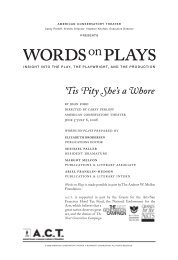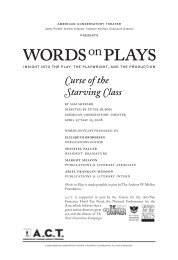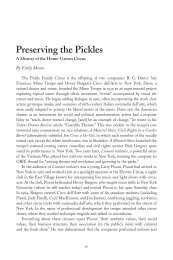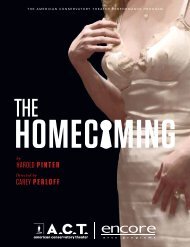Hedda Gabler - American Conservatory Theater
Hedda Gabler - American Conservatory Theater
Hedda Gabler - American Conservatory Theater
You also want an ePaper? Increase the reach of your titles
YUMPU automatically turns print PDFs into web optimized ePapers that Google loves.
or had been secretly married and divorced before marrying the<br />
man who in the play is her husband. In any event, her sin was a<br />
transgression of the moral law as understood by the community,<br />
and to atone for her sin either she would kill herself or die a painful<br />
tubercular death; with her sacrifi ce, the community’s health and<br />
balance would be restored.<br />
The community’s moral law was<br />
usually represented by a male character<br />
who belonged to a respected profession.<br />
He was a doctor, a lawyer, or a political<br />
fi gure who, through advice and behavior,<br />
demonstrated to people on both sides of<br />
the proscenium the best, most moral way<br />
to live. He was the model citizen; as the<br />
ironic title of an Ibsen play puts it, he was<br />
one of The Pillars of the Community.<br />
Ibsen took melodrama and the wellmade<br />
play and turned them on their<br />
heads. Where they showed a simple moral<br />
universe he insisted that the world was<br />
complex. If their moral was that social<br />
conformity was every person’s duty, he<br />
would show that the goal was to become<br />
the person you truly are, regardless of<br />
what the community thought. For a<br />
character like Nora in A Doll’s House,<br />
there is more than one way to realize<br />
one’s humanity; for Doctor Stockmann,<br />
the community’s way is not only the<br />
wrong way, it’s literally the way to death:<br />
so he becomes An Enemy of the People.<br />
The tragedy for someone like <strong>Hedda</strong><br />
Tesman (née <strong>Gabler</strong>) is that she lacks<br />
the courage to become her own authentic<br />
self. She is smothered by the community’s<br />
narrowness and lack of imagination and<br />
by her own inability to defy its restraints<br />
and make a place for herself in the world as<br />
wild and as large as her dreams had been.<br />
The model citizen of her community<br />
is Commissioner Brack: a known and<br />
respected fi gure in the town—but whom<br />
we come to see as an opportunistic,<br />
lecherous blackmailer. That is what Ibsen<br />
N 126<br />
By Edvard Munch<br />
does to these male exemplars of civic virtue: he kicks them off their<br />
pedestals and shows us that no one, not even the most respected<br />
pillar of society, has the inherent moral authority to tell another<br />
person how to live. In A Doll’s House, the traditional model citizen<br />
is Dr. Rank. Doctors were popular in these roles: they had good<br />
reason to be constantly at the main characters’ house (a seemingly<br />
I would far rather be an outcast<br />
upon the bosom of the great world<br />
than be an accomplice to<br />
a moral nothingness<br />
rather a bloody spark that<br />
no hand will shield<br />
that glows wildly and is extinguished<br />
and obliterated with no trace<br />
than glow as a lamp<br />
with a calm measured fl ame<br />
evening after evening<br />
in that eternal sitting-room<br />
where the canary slumbers<br />
in its blanket-covered cage<br />
and time is slowly counted out<br />
by the old sitting-room clock<br />
no the spark has the ability<br />
to light the fi re<br />
and to know that it was responsible<br />
for the sound of the fi re siren<br />
to know it was responsible<br />
for the sea of fl ames<br />
that broke with tradition<br />
and turned the hourglass upside down.<br />
Munch in His Own Words,<br />
by Poul Erik Tojner<br />
(Prestel Publishing, 2001)<br />
good middle-class house in which the moral rot has yet to be<br />
exposed), their knowledge and good deeds were admired, and the<br />
medical metaphor was obvious. Dr. Rank, however, is in love with<br />
another man’s wife, and worse (according to the mores of the day),<br />
he tells her. Worse still, he carries within him venereal a disease<br />
that will kill him soon after the play is<br />
over. While audiences were outraged by<br />
the sight of a sane middle-class woman<br />
leaving her husband and children, many<br />
were just as shocked by the notion of<br />
a venerated community figure—and<br />
the values he represented—so fatally<br />
compromised.<br />
Ibsen paid for his boldness by seeing<br />
his plays banned across Europe. For many<br />
years, only the small “private” theaters,<br />
which played just to their members (and<br />
thus operated beneath the censorship to<br />
which all public European theaters were<br />
subject) could produce his plays. When<br />
Ghosts was produced by such a theater<br />
in London in 1891, one paper declared<br />
it “as foul and fi lthy a concoction as has<br />
ever been allowed to disgrace the boards<br />
of an English theatre.”<br />
Yet, in his last years, when he returned<br />
from self-imposed exile to Norway, Ibsen<br />
was showered with medals and honors<br />
(some of which he eagerly solicited),<br />
and by World War II he had become<br />
one of the most frequently performed<br />
playwrights in Europe. As his prose<br />
plays became increasingly familiar, he<br />
became known as a writer of realistic plays<br />
about social problems, which he never<br />
considered himself to be.<br />
In fact, Ibsen was the first major<br />
playwright since the Romantics to<br />
champion individuals over their<br />
community—but then, Ibsen, despite<br />
the realistic trappings of his prose plays,<br />
always remained the Romantic visionary<br />
of his early poetic ones. Ibsen showed that<br />
even within a single play there was more<br />
than one way to be, for in his work, realism is forever bumping up<br />
against poetic imagery that resonates beyond our ability to give<br />
it a simple meaning. He also invented subtext—the idea that a<br />
line of dialogue could have one meaning to the person speaking<br />
it, another to the person hearing it, and a third one, contradicting<br />
the other two, to the audience. In doing so, he exposed the deep<br />
continued on page 12<br />
<strong>Hedda</strong> <strong>Gabler</strong> 9

















